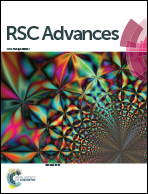Temperature-sensitive carbon dots derived from poly(N-isopropylacrylamide) for fluorescence on–off properties†
Abstract
Here, we report novel thermo-responsive fluorescent nanoparticles of carbonized poly(N-isopropylacrylamide) (PNIPAAm) through two pathways, partial carbonized PNIPAAm (F-PNIPAAm) and full carbonized PNIPAAm (FNP) acid treatment. The carbonized PNIPAAm generated different properties depending on acid treatment time to control the lower critical solution temperature (LCST) behaviors as a biosensor based on a fluorescence on–off system. Furthermore, the FNP–PNIPAAm also showed reversible capability based on fluorescence intensity, with a high fluorescence signal observed at room temperature (25 °C) but quenching at physiological temperature (37 °C). H-NMR, FT-IR, X-ray dispersion (XRD), and X-ray photoelectron spectroscopy (XPS) confirmed the associated chemical moieties of FNP–PNIPAAm and FNP. After confirming the cytotoxicity of the prepared material, we carried out in vitro bio-imaging studies using MDAMB, A-549, and MDCK cells by confocal laser-scanning microscopy. Therefore, we successfully established a convenient, rapid, and ecofriendly synthetic approach to the synthesis of FNPs based on PNIPAAm. These FNPs exhibited tunable luminescence properties, high aqueous stability, and low cytotoxicity, suggesting potential applications in bio-labeling, bio-imaging, and optoelectronics.



 Please wait while we load your content...
Please wait while we load your content...